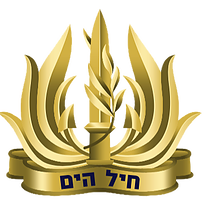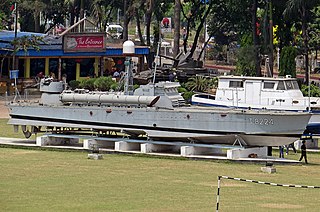Related Research Articles

In naval terminology, a destroyer is a fast, maneuverable, long-endurance warship intended to escort larger vessels in a fleet, convoy or battle group and defend them against powerful short range attackers. They were originally developed in 1885 by Fernando Villaamil for the Spanish Navy as a defense against torpedo boats, and by the time of the Russo-Japanese War in 1904, these "torpedo boat destroyers" (TBDs) were "large, swift, and powerfully armed torpedo boats designed to destroy other torpedo boats". Although the term "destroyer" had been used interchangeably with "TBD" and "torpedo boat destroyer" by navies since 1892, the term "torpedo boat destroyer" had been generally shortened to simply "destroyer" by nearly all navies by the First World War.

U-boats were naval submarines operated by Germany, particularly in the First and Second World Wars. Although at times they were efficient fleet weapons against enemy naval warships, they were most effectively used in an economic warfare role and enforcing a naval blockade against enemy shipping. The primary targets of the U-boat campaigns in both wars were the merchant convoys bringing supplies from Canada and other parts of the British Empire, and from the United States, to the United Kingdom and to the Soviet Union and the Allied territories in the Mediterranean. German submarines also destroyed Brazilian merchant ships during World War II, causing Brazil to declare war on both Germany and Italy on 22 August 1942.

An anti-ship missile (AShM) is a guided missile that is designed for use against ships and large boats. Most anti-ship missiles are of the sea skimming variety, and many use a combination of inertial guidance and active radar homing. A good number of other anti-ship missiles use infrared homing to follow the heat that is emitted by a ship; it is also possible for anti-ship missiles to be guided by radio command all the way.

Tench-class submarines were a type of submarine built for the United States Navy (USN) between 1944 and 1951. They were an improvement over the Gato and Balao classes, only about 35 to 40 tons larger, but more strongly built and with a slightly improved internal layout. One of the ballast tanks was converted to carry fuel, increasing range from 11,000 nautical miles to 16,000 nautical miles. This improvement was also made on some boats of the previous two classes. Further improvements were made beginning with SS-435, which are sometimes referred to as the Corsair class. Initial plans called for 80 to be built, but 51 were cancelled in 1944 and 1945 when it became apparent that they would not be needed to defeat Japan. The remaining 29 were commissioned between October 1944 (Tench) and February 1951 (Grenadier). The last submarine of the Tench class, as well as the last submarine which served during World War II, remaining in service with the U.S. Navy was USS Tigrone (AGSS-419) which was decommissioned on 27 June 1975.

The P-15 Termit is an anti-ship missile developed by the Soviet Union's Raduga design bureau in the 1950s. Its GRAU designation was 4K40, its NATO reporting name was Styx or SS-N-2. China acquired the design in 1958 and created at least four versions: the CSS-N-1 Scrubbrush and CSS-N-2 versions were developed for ship-launched operation, while the CSS-C-2 Silkworm and CSS-C-3 Seersucker were used for coastal defence. Other names for this basic type of missile include: HY-1, SY-1, and FL-1 Flying Dragon, North Korean local produced KN-1 or KN-01, derived from both Silkworm variants and Russian & USSR P-15, Rubezh, P-20 P-22.

The Israeli Navy is the naval warfare service arm of the Israel Defense Forces, operating primarily in the Mediterranean Sea theater as well as the Gulf of Eilat and the Red Sea theater. The current commander in chief of the Israeli Navy is Aluf David Sa'ar Salama. The Israeli Navy is believed to be responsible for maintaining Israel's offshore nuclear second strike capability.

The Republic of China Navy, also called the ROC Navy and colloquially the Taiwan Navy, is the maritime branch of the Republic of China Armed Forces (ROCAF).

A missile boat or missile cutter is a small, fast warship armed with anti-ship missiles. Being smaller than other warships such as destroyers and frigates, missile boats are popular with nations interested in forming a navy at lower cost. They are similar in concept to the torpedo boats of World War II; in fact, the first missile boats were modified torpedo boats with the torpedo tubes replaced by missile tubes.

The Type 214 is a diesel-electric submarine developed by Howaldtswerke-Deutsche Werft GmbH (HDW). It features diesel propulsion with an air-independent propulsion (AIP) system using Siemens polymer electrolyte membrane (PEM) hydrogen fuel cells. The class is exclusively designed for export market. The submarine class combines the design principles of the Type 209 family and the features of the Type 212A submarines. However, as an export design, it lacks some of the classified technologies of the smaller Type 212, the most important of which is probably the non-magnetic steel hull, which makes the Type 212 submarine difficult to detect using a magnetic anomaly detector.

A stealth ship is a ship that employs stealth technology construction techniques in an effort to make it harder to detect by one or more of radar, visual, sonar, and infrared methods.

The Type 039 submarine is a class of diesel-electric submarines of the People's Liberation Army Navy. The class is the first diesel-electric submarine to be fully developed within China and also the first Chinese diesel-electric submarine to use the modern teardrop hull shape.

The C-704 is a Chinese anti-ship missile. The missile was developed by the third research institute of the Chinese Aerospace Group, also the manufacturer of the C-701.

The P 4 class torpedo boat (TB) were aluminum-hulled torpedo boats of the People's Republic of China's People's Liberation Army Navy. Based on the Soviet K-123 hydroplane design, they were armed with twin 14.5-millimetre (0.57 in) machine guns, and two 17-inch (43 cm) torpedoes. This class is currently considered obsolete, but was not completely retired from active service, being placed in reserve until the mid-1990s.

The Type 025 torpedo boat, also known as the Huchuan or Hu Chwan class, was once the backbone of the People's Liberation Army Navy (PLAN) in its confrontations with its much larger opponents in the Republic of China Navy. Although no longer serving in that capacity, this class is still active. While relatively unsophisticated, the class has enjoyed a longevity in active service thanks to a philosophy within PLAN which has continued to favor its use. Powered by Soviet-era engines, the hydrofoil-equipped boats are capable of 50 knots and carry two torpedo tubes for torpedoes, with some known to be armed with naval mines.

The C 14 class missile boat is a light missile boat of catamaran designed for use in the Middle East, also known as the China Cat class. The small size of the ship, along with some stealth features provide it with good protection against enemy detection, and it can be armed with a variety of light anti-ship missiles. In addition to the low radar cross section, the boat is also extremely fast with an aluminum monohull with stepped planning.

The Type 22 missile boat is a ship class in the Chinese People's Liberation Army Navy. The first boat was launched in April 2004 by the Hudong-Zhonghua Shipyard at Shanghai. The boats incorporate stealth features and are based on Australian-designed wave-piercing catamaran hulls that are more stable than other fast missile craft in high sea conditions. 82 of these missile boats are currently in service with three flotillas having been produced over a span of seven years, operating in squadrons of eight vessels each.

The Project 205 Moskit (mosquito) more commonly known by their NATO reporting name Osa, are a class of missile boats developed for the Soviet Navy in the late 1950s. Until 1962 this was classified as a large torpedo boat.

The Myanmar Navy is the naval warfare branch of the armed forces of Myanmar. With 24,000 personnel on duty, the navy operates more than 150 vessels. Prior to 1988, the navy was small, and its role in counter-insurgency operations was smaller than those of the army and the air force. The navy has since been expanded to take on a more active role in defense of Myanmar's territorial waters.

The BRP Rizal (PS-74) was the lead ship and first of two Rizal class ships in service with the Philippine Navy. She was an ex-USN Auk class minesweeper that was produced during World War II, and was classified as a patrol corvette protecting the vast waters of the Philippines. Along with other ex-World War II veteran ships of the Philippine Navy, she was considered one of the oldest active fighting ships in the world, until 2020.
Type 512 radar is the Chinese license-produced Soviet Zarnitsa naval radar that has been withdrawn from service in Chinese navy.